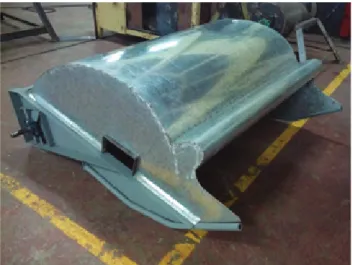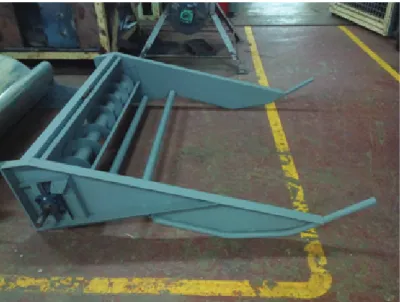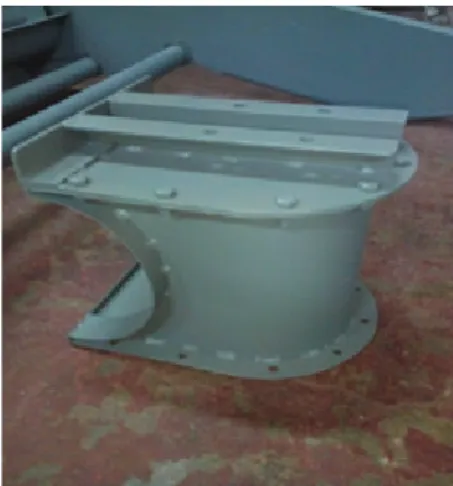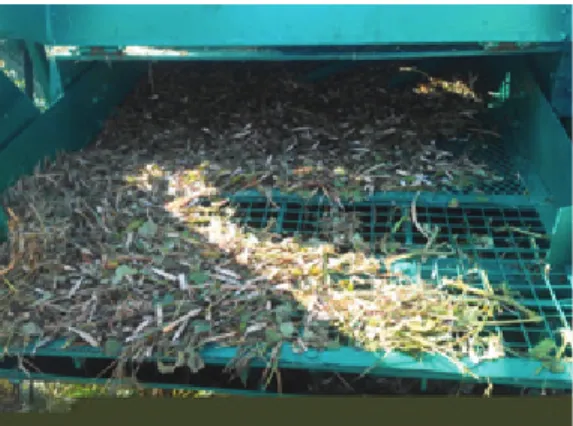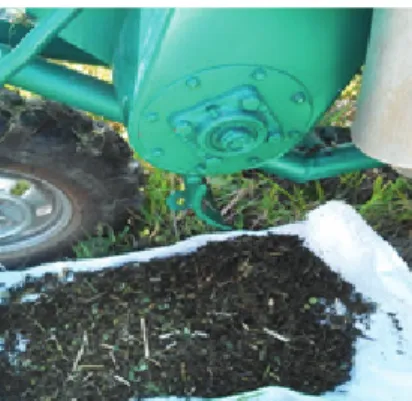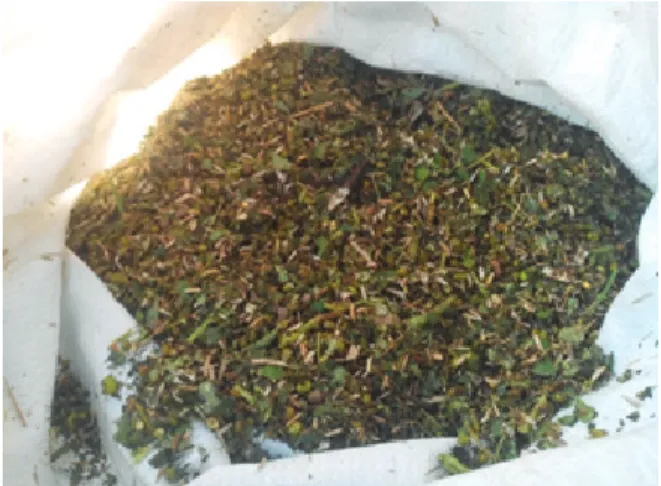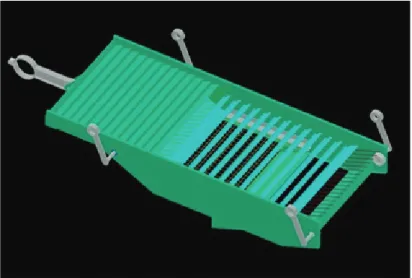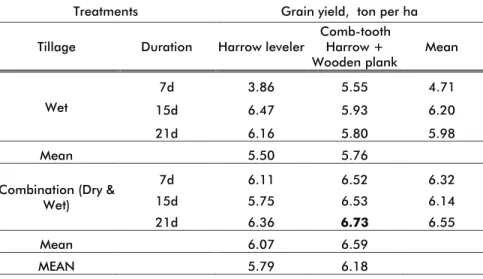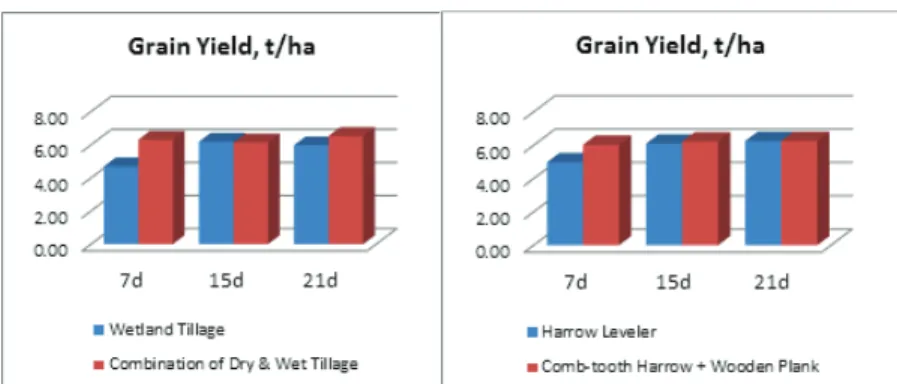RICE ENGINEERING and
MECHANIZATION DIVISION
TABLE OF CONTENTS
Executive Summary
Rice Engineering and Mechanization Division
Page 1 I. Development of Production and Postproduction Farm
Machinery 1
II. Development of an Integrated Postharvest Management
System for the Rice Postproduction Industry 17 III. Commercialization of Matured Engineering
Technologies 22
Abbreviations and acronymns 26
List of Tables 28
List of Figures 39
Rice Engineering and Mechanization Division
Division Head: EB Sibayan
Executive Summary
For 2014, there are three projects implemented under the division.
The first project is on the development of production and post - production technologies which has six studies. The ride on stripper combine harvester is being improved, the multi-functionality of the combine harvester is being considered so that it can be used in other crops such as mungbean especially in the case of Isabela. The improvement of the protocol on land preparation was also studied and the performance of the ACEF-PhilRice custom service project was evaluated. There are two new studies included in this project which were both conducted in PhilRice Batac, i.e. Design and Development of Carbonized Rice Hull (CRH)-Insulated Silo to Reduce Storage Losses and the Survey of Existing Hydraulic Ram Pump (HRP) as initial part of the study Design, Performance and Field Evaluation of a Downdraft Hydraulic Ram Pump for Irrigating Rice-based Crops in Ilocos
Project 3 addresses the promotion of the matured technologies that were developed in the previous years and those that are to be completed.
Since the institute was not mandated to commercialize the technologies generated, promotion was done mainly through attendance to field days and similar activities organized by the local government units (LGUs), the Regional Field Offices (RFOs) of the DA and other government and non- government organizations.
To cater to the demand on the different equipment, accreditation of qualified and willing manufacturers was continued. Under the scheme, the mass production and manufacture of the identified equipment were no longer handled by the institute. However, training of staff of the accredited manufacturers can be provided with corresponding fee.
I. Development of Production and Postproduction Farm Machinery
Project Leader: CJM Tado
Development of Ride-on Stripper Combine CJM Tado, DP Ona
Postharvest losses start during harvesting and threshing operations.
Timely harvesting and threshing is essential if we are to keep losses to a minimum. However, harvesting in the Philippines is still mostly done
manually, requiring 16 to 25 man-days per hectare. Furthermore, labor shortage at harvest time is now a reality in many major rice-producing areas in the country. A combine harvester that can operate well in Philippine rice fields is thus essential in improving timeliness of operation and reduction of postharvest losses, especially in large rice-producing provinces where harvest labor is now becoming scarce.
Highlights:
• The prototype design has been started. Component speeds, sizes, and materials were established and identified.
Parameters such as rotational speed and air velocity were set within the allowable range to minimize losses and crop damage.
• 3D model, working drawings, patterns and jigs were generated using computer-aided design (CAD).
• The fabrication of the header assembly (Figure 1) is already completed. Major components such as the feeder conveyor, thresher, cleaner, blower, screw conveyors, platform, chassis, and undercarriage will be fabricated at Rice Engineering and Mechanization Division (REMD) machine shop. Some parts such as gears, undercarriage rollers, and hydraulics will be outsourced from the members of Metalworking Industries Association of the Philippines, Inc. (MIAP).
Figure 1. Fabricated stripper header hood.
Figure 2. Intake auger inside the stripper header.
Figure 3. Feeder auger inlet.
Improvement of the Combine Harvester CJM Tado, DP Ona
Planting of mungbean after rice has been proven to be a profitable practice of farmers in Region 2. However, harvesting of mungbean is still done manually, requiring more labor. Mechanized harvesting of mungbean speeds up the harvesting operation and leads to reduction of postharvest losses. The rice combine which was designed to solve the growing problem of labor scarcity felt in most major rice growing areas of the country, can be modified so that it will be able to harvest mungbean.
Highlights:
• A preliminary test was conducted to determine the
performance of the previous design of PhilRice Mini Combine on mungbean. During the operation, matting of harvested materials was observed on the oscillating sieve (Figure 4). The recycling conveyor clogs due to high moisture MOG (material other than grain) (Figure 5). Harvested mungbean contains at least 50% MOG (Figure 6). Based on the results, a major modification should be made on the cleaning assembly and on the recycling conveyor.
• The cleaning assembly having a replaceable sieve to cater both rice and mungbean has already been designed (Figure 7).
• The prototype design has been started. Component speeds, sizes, and materials were established and identified.
Parameters such as rotational speed and air velocity were set within the allowable range to minimize losses and crop damage.
• 3D model, working drawings, patterns and jigs were generated using computer-aided design (CAD).
Figure 4. Matting of harvested materials on oscillating sieve.
Figure 5. Clogged materials on the recycling conveyor.
Figure 6. Harvested mungbean with over 50% MOG.
Figure 7. New design of cleaning assembly (with replaceable oscillating sieve).
Improvement of PalayCheck Protocol for Land Preparation HV Valdez, KS Pascual, EG Bautista, EC Gagelonia , CJM Tado
Land preparation is one of the most important processes in rice production. A well-prepared land provides a soil condition favorable for plant growth. It also facilitates good management on water, nutrient, weed and pest. Proper leveling in the field, for example, solves more than 50% on the problems in rice production. This study evaluated different duration of land preparation and degree of final leveling in the field to assess their effect on the agronomic performance on the crop and weed incidence. It also aims to improve and develop a protocol of land preparation for PalayCheck in order to establish an environment ideal for crop growth.
For 2014 dry season, three factorial combinations was used with tillage operation as the main plot, land preparation duration as the sub-plot, and method of leveling as the sub-sub-plot laid out in split-split plot design in RCBD. The 2 tillage operations were: (1) wet using power tiller with 2-disc plow (plowing) and harrow cum leveler attachment (first and second harrowing); and (2) combination of dry and wet using 4-wheel tractor with rotovator (dry plowing) and succeeding operation (wet) using power tiller with harrow cum leveler attachment (first and second harrowing). The 3 durations of land preparation were: (1) 7d with two day interval of plowing, first harrowing, second harrowing, and leveling; (2) 15d with 5 days interval;
and (3) 21d with 7d interval. The methods of leveling were: (1) using harrow leveler; and (2) using comb-tooth harrow + wooden plank.
Highlights:
• In 2014 DS, grain yield (Table 1) was not significantly affected by the interacting effects of both treatments. The 21d-comb tooth harrow + wooden plank leveled soil (Combination of dry & wet tillage) obtained the highest (6.73t/ha) while 7d-harrow leveler leveled soil obtained the lowest (3.86t/ha).
• Among the methods of leveling, grain yield of a comb-tooth harrow + wooden plank leveled soil was higher by 6.34%
compared with that of the harrow leveler.
• In 2014 DS, at 15 & 30DAT, weed densities were significantly influenced by tillage operation and duration of land
preparation. At 15 & 30DAT, weed density was highest at shortest duration 7d (wetland tillage) with 108 plants/m2 and 116 plants/m2, but not significantly different with 7d and 15d (combination of wet & dry tillage) 54 plants/m2 and 115 plants/m2, respectively.
Table 1. Grain yield of NSIC Rc298 (t/ha) under different tillage operation, land preparation duration and degree of leveling the soil, 2014 DS.
Table 1. Grain yield of NSIC Rc298 (t/ha) under different tillage operation, land preparation duration and degree of leveling the soil, 2014 DS
Treatments Grain yield, ton per ha
Tillage Duration Harrow leveler Comb-tooth Harrow +
Wooden plank Mean
Wet
7d 3.86 5.55 4.71
15d 6.47 5.93 6.20
21d 6.16 5.80 5.98
Mean 5.50 5.76
Combination (Dry &
Wet)
7d 6.11 6.52 6.32
15d 5.75 6.53 6.14
21d 6.36 6.73 6.55
Mean 6.07 6.59
MEAN 5.79 6.18
Table 2. Weed density (plants/m2) under different tillage operation, land preparation duration and degree of leveling the soil at 15DAT & 30DAT, 2014 DS.Table 2. Weed density (plants/m2) under different tillage operation, land preparation duration and degree of leveling the soil at 15DAT & 30DAT, 2014 DS
Treatments Weed density, plants per m2
Tillage Duration 15DAT 30DAT
Wet
7d 108 A 116 A
15d 29 B 35 B
21d 29 B 39 B
Combination (Dry &
Wet)
7d 33 B 54 AB
15d 46 B 115 A
21d 20 B 35 B
Data in columns with the same capital letter are not significantly different at P<05 level using LSD.
Figure 8. Grain yield of NSIC Rc298 (t/ha) under different tillage operation, land preparation duration and method of leveling the soil, 2014 DS.
Evaluation of PhilRice-ACEF Project on Custom Service Provision for Rice Mechanization
EC Gagelonia, RA Villota
The Custom Service Provision for Rice Farm Mechanization Project was funded by the DA-ACEF and Philippine Rice Research Institute, with the agreement of a 55:45 equity ratio respectively. The project was implemented for six (6) years term and with a total budgetary requirement of Php 31,000,370.00. The total budgetary requirement was shared by the ACEF loan component for Php 17,006,500.00 and proponent equity of Php 13,993,870.00.
The project aims to be able (1) to contribute in the goal of modernizing the Philippine agriculture through agricultural mechanization to complement the other components of the rice farming and related
operations (2) to develop and pilot test a farm mechanization model which involves the putting up of a farm machinery, equipment and transport vehicle pool that will custom the mechanization needs of rice farmers for various fields operations (3) to promote and commercialize the rice farm mechanization model to the 14 rice producing regions in the country and (4) to promote and commercialize the rice farm mechanization model to the private entrepreneurs in 56 rice producing provinces in the country.
Highlights:
• The original proposal of a “Subsidiary Company,” to be operated as a private business enterprise was not implemented due to financial legality problem within PhilRice as a
government corporation as well as the Memorandum of Agreement signed by the PhilRice Executive Director, being PhilRice as the recipient of the loan from the DA-ACEF.
• The PhilRice-ACEF project operation was integrated with the Rice Engineering and Mechanization Division (REMD), instead of establishing a subsidiary company. Establishment of project management organizational structure was formed with the REMD head as the project manager and selected REMD personnel as project staff.
• The primary beneficiary of the project were the farmers in Barangay Maragol, Science City of Muñoz, Nueva Ecija. The farmers were relieved of the need to procure their own farm equipment, which in general are only utilized for a few days in a year. And the secondary beneficiary will be the private sector who will invest in this kind of project. However, due to conflicts with the officers of the farmers’ cooperative in Maragol, the beneficiary of the project was transferred to Bantug Multipurpose Cooperative.
• Financial performance of the project during the first seven years (2006 to 2012) is shown in Figure 9.
• In 2011 due to increasing amortization per quarter and the decreasing income generated, the project could no longer pay the scheduled amortization.
• The PhilRice-ACEF project management, after its self- evaluation of the project operation, decided to make the request for restructuring of loan repayment. The request was approved in principle and had consistently made the reduced amortization payments for the last 3 years and will hopefully finish full payment by November of 2016.
• The problems encountered during operation of the project were: fast turnover of project in-charge, prioritization of PhilRice farm operation with that of regular client, unpaid services/not religiously paying obligations, payments were not regularly monitored/audited, operators/laborers time not maximized.
• With the aim to consolidate the management and operation of all income generating sources to the PhilRice Business Development Divisions (BDD), the project was transferred to BDD per Administrative Order No. 2013-06 dated 19 April 2013.
Figure 9. Summary of Income 2006-2012.
Design and Development of Carbonized Rice Hull (CRH)-Insulated Silo to Reduce Storage Losses
DP Dal-uyen, LC Taguda, MAU Baradi, CJM Tado, BM Catudan, FP Bongat Rice (Oryza sativa L.) is a staple food consumed by almost all of the population in the Philippines and can be produced twice a year in irrigated areas and once a year in rainfed areas. Losses from harvesting to storage were estimated by Castro (2003) to be roughly 15% on the average, ranging from 1 to 32%; 18% of which are incurred during storage. This translates to 2.7% contribution of storage to overall harvest and postharvest losses. With the 18.4 million metric ton (MT) paddy produced by the country in 2013 (BAS, 2015), this translates 0.5 million MT lost from storage. At 65% milling recovery, this loss from storage can feed 2.7 million Filipinos in a year.
This study generally aimed to design and develop village-type rice silo appropriate for rice storage by small scale farmers.
Highlights:
Design of rice silo
• This silo was designed considering the storage parameters of milled rice and paddy rice (unmilled) including moisture content (MC). Also, some engineering properties such as the capacity/density of rice, loading and unloading were also considered. Therefore, the ease of the operation in the loading and unloading in the silo was given attention. Design of rice silo was prepared as shown in Figure 10.
• Cylindrical shape was selected for the design. The design of the body was double-walled with provision of an insulating material between the walls purposely to reduce the
temperature fluctuation and relative humidity (RH) within and outside of the silo.
• Cover of the silo used an airtight material to enclose securely the stored grains to avoid penetration of air. The unloading was designed at the bottom portion for ease of unloading.
Fabrication of one-ton silo
• One-ton silo was fabricated to store and prolong the storability of unmilled rice as shown in Figure 11. Based from the result of the FGD, problems encountered by farmers, rice miller and fabricator was the basis in designing the silo therefore, interventions was made to address and consider the problems encountered as shown in Table 3.
• The space between the two cylinder is purposely for insulation to control the fluctuating temperature between the outside and inside of the inner cylinder. Carbonized Rice Hull (CRH) was chosen as insulating material and also purposely to prolong the storability of the silo and absorb moisture of the grains to be stored. Using CRH to prolong storability of crop was proven by a young farmer from Ilocos Sur that made him “Outstanding Young Farmer” in 2010. Biological control for weevil and molds was being emphasized as one of the enumerated problems of farmers during storage that could contribute high losses during storage. Frame was provided to hold the silo and ladder to ease loading of the grains to be stored.
Table 3. Problems encountered during storage using traditional storage (“garung”) vs. intervention made.
PROBLEMS EFFECT TO FARMERS INTERVENTIONS MADE
Loading Need ladder just to load the
rice in their garung.
Attachment of two-step ladder exact for loading the grains.
Unloading Difficulty in unloading the rice from the top of their garung.
Flexible unloading placed at the bottom of silo.
Dustiness (white powder) of
the stored rice Dusty grains show low quality of the grain.
Sealed the silo.
Birds and chicken Losses during storage. Sealed the silo.
Rodents Losses during storage. Sealed the silo.
Application of chemicals Using chemicals such as Naptalene, Malathione, etc causing hazard to consumers.
Using biological control such as dry leaves of lagundi, eucalyptos and neem tree.
Weevil Low quality resulting to low
income.
Sealed the silo.
Decaying of the paddy during
rainy seasons Molding of grains Insulation made to control the temperature fluctuation between inside and outside of the silo.
Spacious (inside location
specially during rainy season) Need space inside the house. Can be placed outside even during rainy season.
Figure10. Schematic diagram of the rice silo.
Figure 11. Fabricated rice silo.
Design, Performance and Field Evaluation of a Downdraft Hydraulic Ram Pump for Irrigating Rice-based Crops in Ilocos: Survey of Existing Hydraulic Ram Pump (HRP) in the Country and Identification of Areas for Improvement
ND Ganotisi, MLO Quigao, MG Galera
Generally, internal combustion engine, electric pump and manual hauling are used to lift water from water source to their compound. Using internal combustion engines or electric motor to prime move water pumps is very expensive because of the escalating price of fossil fuels and electric power. Besides, fossil fuels when burned due to combustion, carbon dioxide is emitted which greatly add heat to the environment enhancing global warming.
Using renewable energy source for pumping water for irrigation like a hydraulic ram pump is deemed necessary, and may result to more productivity and production in arid and hilly areas of the region. A hydraulic ram pump is a pump that pushes water uphill using energy from falling water.
It is a device with simple and conveniently applied mechanism by which the weight of water can be made for raising a portion of itself to a considerable height. It is inexpensive; virtually maintenance free; easy to install, parts are at any time available in the locality; self-acting; requires low water drop source but dependably and consistently pump a portion of that source uphill; and does not require outside source of energy to operate. The study aimed at identifying areas for improvement of the hydraulic ram pump for Northwest Luzon conditions was conducted. A survey of existing hydraulic ram pump (HRP) in the country particularly in Alaminos, Laguna and Nueva
Era, Ilocos Norte were undertaken aside from scanning available HRPs from the internet.
Highlights:
• Based from profiling and characterization, the HRP installed in Laguna has a body of the pump made of G.I. tee and elbow of 4 inches diameter welded together. The flanges are mild steel plates, with air chamber made of G.I pipe with 6” diameter.
It was fabricated using lathe machine made from iron plate.
It has a discharge pump rate of 20,000 li per day with the elevation of the catchment from the pump of 8 m and lift the water to the storage tank at 30m above the pump. The water is used for household and irrigation of crops. On the other hand, the HRP installed in Nueva Era, Ilocos Norte has a drive pipe of 2” with elevation of the catchment from the pump of 3 to 5m. It has delivery pipe of 1” and can lift the water 10 to 15m directly to field crop. It was made of G.I pipes fittings, tee (2” diameter), coupling (4” and 2” diameter), bushing (4”x2”
diameter) threaded together (Table 4).
• Through internet surfing, the AIDFI installed an HRP in Bacolod City, Negros Occidental. The pump can benefit 20 to 100 household or more, and it can pump water uphill to a maximum height of 200 meters. The HRP pump the water up to 30 to 40 times the height of the water source from the pump. AIDFI sells HRP in different sizes and flow rates.
• PASALI Philippine Foundation, Inc., an organization active in Mindanao, located in Brgy. Fatima, General Santos, Mindanao has completed a project on Spring Development and Installation of Level II Water System through HRP in eight sites of Brgy. Tungao, Butuan City from May to August 2014 in partnership with AIDFI. Another HRP was being installed by the PASALI in Brgy. Limulan Sitio Minurok, Kalamasig, Sultan Kudarat under the agos RAM Pump Project of AIDFI. Three Manobo (an indigenous group) villages with a total of 100 households located more than 500 meters above the sea level were given free flowing potable water through the pump.
• The problems encountered include leakage of water from the pump which reduced pressure and decreased pump discharge rate. The pump does not start by itself and the pressure gauge deteriorates.
• The future activities of the study include survey and identify areas in Ilocos Norte and Ilocos Sur where HRP is applicable;
Adopt existing HRP and verify its performance and
demonstrate in Ilocos Norte and Ilocos Sur; and to conduct on-farm evaluation of HRP in irrigating rice and rice-based crops.
Table 4. Profile and characteristics of HRP installed in Laguna and Ilocos Norte.Table 4. Profile and characteristics of HRP installed in Laguna and Ilocos Norte.
Parameters Alaminos, Laguna Nueva Era, Ilocos Norte Background Information:
Name of caretaker Jovito de Mesa Jimmy C. Soliven
Address Brgy. San Gregoio, Alaminos,
Laguna
Brgy. Bugayong, Nueva Era, I.
N.
Date Installed 2006 -
Fabricator Roberto, A. Alaban, Jr. Dr. Arnold F. Dumaoal Technical Parts:
Ram pump design name ET-2 Downdraft HRP, 2”
Source of water River Diversion canal
Materials of the catchment tank
Reservoir Earth embankment
Elevation of the catchment tank from pump
8 m 3-5 m
Materials of the drive pipe G. I. pipe G. I. pipe
Drive pipe length - Approx. 10 m
Flow rate of the drive pipe - -
Delivery pipe diameter 2” 1”
Materials of the delivery pipe Irrigation hose Irrigation hose Elevation of the storage tank
from pump
30 m Water was directed to the field
(elevation was approx.. 10-15m from pump to field)
Diameter and materials of the pump body
The body of the pump was made of 4”G.I. tee and elbow welded together, the flanges are mild steel plates, the air chamber was 6” G.I pipe (Fig. 12).
It was made of 2” G.I pipe and tee fittings, 4” and 2” G.I.
couplings, 4”x 2” bushing threaded together (Fig. 13).
Impulse, Delivery valve and snifter valve
It was fabricated using lathe machine made from iron plate.
It was made from 2”
commercial check and spring valves. The snifter valve mas made from inner tube of tricycle wheels.
Figure 12. Different parts of the HRP installed in Brgy. San Gregorio, Alaminos Laguna.
Figure 13. Different parts of the HRP installed in Brgy. Bugayong, Nueva Era, Ilocos Norte.
II. Development of an Integrated Postharvest Management System for the Rice Postproduction Industry
Project Leader: MJC Regalado
Development of Postharvest Management Keychecks and Best Practices for Improving the Post-Production System
MJC Regalado, PS Ramos
Postharvest losses can be as high as 30% of production depending on processing and handling circumstances. Physical losses are mainly due to spillage or pest infestation. The more critical losses are the loss in quality due to bio-deterioration, and damage to the grain during drying, storage, and milling. Qualitative losses are also due to discoloration, presence of contaminants, varietal mixing, and grain fissures that wind up as broken kernels during milling. Severe grain fissuring causes a reduction in milling recovery, and broken grains sell for only half the price of head rice. All of these losses can be minimized through technology, information dissemination, and training of technicians. A focus on producing good quality rice automatically reduces postharvest losses.
Minimizing postharvest losses and producing good quality milled rice are two sides of the same coin, and is dependent on the farming system and associated practices of producing good quality palay and the downstream processing industry.
In the post-production system, the way of doing things with the aid of tools, machines, or processing equipment, in short, use of technology, are key elements. Harvesting machines to provide timeliness, mechanical dryers to arrest bio-deterioration of the wet harvest, good storage facilities, and efficient rice milling machines are required. It is sad to note that despite rice being the staple food of the country, the confluence of negative events contributes to an obsolete post-production system that we have today.
The study aims to develop and test a PalayCheck® system for integrated rice postproduction management, covering harvesting, threshing, hauling, cleaning, drying, storing, and milling operations.
Highlights:
• Results showed that the postharvest losses was affected by the time of harvesting, the optimum time of harvest has lowest postharvest losses (cutting, piling & threshing) compared with the early and late harvest time. And also the cut/piled/threshed within a day resulted to lowest losses compared with the delayed piling and threshing.
• Combine harvesting method resulted lowest losses both in the early, delayed and optimum time of harvest.
• Milling properties were affected by the method of drying (mechanical drying & sun drying). Mechanical drying has high milling recovery compared with sundrying samples, the same results also for the headrice recovery.
• Milling recovery and headrice recovery were affected by the time of harvesting. The cut/piled/threshed within the day resulted to high milling and headrice recovery.
• Based on the results, germination was affected by the method of storage, the samples stored in hermetic storage (saclob) maintain the germination percentage compared with the samples stored in an open storage.
• The data presented below is only one year (1DS, 1WS), it will be verified for the next two cropping season for the best results.
DS 2014
WS 2014
III. Commercialization of Matured Engineering Technologies
Project Leader: EC Gagelonia
The task of improving productivity in rice cultivation through the use of yield-enhancing and cost-reducing mechanization technologies falls on the shoulders of PhilRice, as the lead rice R&D institution in the country. In fact, PhilRice, through its Rice Engineering and Mechanization Division, has been at the forefront in the development of production machinery and postharvest equipment for rice production. To date, several of these technologies have already been successfully developed by PhilRice engineers. A vigorous technology transfer strategy is therefore needed in order for these equipment to be adopted by farmers in the countryside. Linkage with the manufacturers are also necessary in the promotion and commercialization of these
technologies.
The following were the tasks and objectives of the project:
• Promote matured engineering technologies for adoption by farmers/
stakeholders.
• Transfer matured engineering technologies to manufacturers for mass production and commercialization.
• Application of patent for new technology prior to commercialization
• Promotion of matured engineering technologies
• Accreditation of manufacturers
• Monitoring of accredited manufacturers for quality validation of the equipment
• Mass production of matured technologies
Highlights:
• Three new technologies have been applied for protection at the Intellectual Property Office (IPOPHIL). These technologies include the ethanol fuel injector for small engine, a continuous flow rice hull gasifier for mechanical grain drying, and a gasifier stove for household cooking.
• Three new manufacturers as shown below were issued a license to manufacture PhilRice machineries such as laboy tiller, microtiller, mobile gasifier, micromill, and brownrice mill. While another manufacturer has ongoing application for the manufacturing of laboy tiller. Once the screening and preparation of documents for that manufacturer are completed then issuance of a license agreement shall be followed.
Manufacturer Address Equipment License validity Val Agri-Machineries
and Machine Shop
23B A. Salvador St., Sta.
Veronica, Guimba, Nueva Ecija
Laboy Tiller and
Microtiller June 9, 2016
G.C.G Welding Shop Sto Rosario, Sto.
Domingo, Guimba,
Nueva Ecija Mobile Gasifier August 1, 2016 Man-Mel Agri-
Enterprises Zone I, Caanawan, San
Jose City, Nueva Ecija Micromill and
Brown Rice Mill July 17, 2016
• Initially, a number of equipment consists of laboy tiller,
microtiller, seed cleaner, micromill, gasifier stove, and combine harvester have been provided to 5 branch stations. Proper documentation for the transfer of those equipment were prepared in close coordination with the property office.
Station Equipment Remarks
PhilRice Agusan laboy tiller, microtiller, seed cleaner MR on process PhilRice Batac laboy tiller, microtiller, mini combine MR completed PhilRice Bicol laboy tiller, microtiller, seed cleaner MR on process PhilRice Los Banos laboy tiller, microtiller, mini
combine, micromill, gasifier stove MR on process PhilRice Midsayap laboy tiller, microtiller MR on process
• Participated on the following field days/ festivals.
o Bambanti Festival at Ilagan City, Isabela (January 2014) o Ullalim Festival at Tabuk City, Kalinga (February 2014) o PhilRice CES Lakbay Palay (April 2014 and October 2014) o 20th Cityhood Anniversary of Santiago City (May 2014) o PhilRice Los Baños Field Day (October 2014)
o PhilRice Bicol Field Day (November 2014)
Figure 14. PhilRice Showroom.
• Fabricated 6 units of 8-ton reversible airflow dryer and installed in the following locations including 1-unit in Bongabon, Nueva Ecija, 3-units in Philrice CMU, and 2-units in PhilRice Midsayap (Figure 15 to 16). Another 2 units of 4-ton reversible airflow dryer were also installed at Malaybalay and Inpasug-ong, Bukidnon through acquisition by Catholic Relief Services.
Figure 15. 8-ton reversible airflow dryer installed in PhilRice CMU.
Figure 16. Testing of 8-ton reversible airflow dryer in PhilRice Midsayap.
• A number of other technologies were fabricated and sold to private individuals including 13 units of manual rotary weeder, 38 units of gasifier stove, 8 units of open-type carbonizer and 1 unit of rice hull stove. In addition, 14 units of laboy tiller were acquired by BFAR Region 3 (Figure 17to18).
Figure 17. 5-units of laboy tiller to be delivered at BFAR Region 3.
Figure 18. 30-units of gasifier stove sold to Mr. Norman Diaz of Samar.
Abbreviations and acronymns
ABA – Abscicic acid Ac – anther culture AC – amylose content
AESA – Agro-ecosystems Analysis AEW – agricultural extension workers AG – anaerobic germination AIS – Agricultural Information System ANOVA – analysis of variance AON – advance observation nursery AT – agricultural technologist AYT – advanced yield trial BCA – biological control agent BLB – bacterial leaf blight BLS – bacterial leaf streak BPH – brown planthopper Bo - boron
BR – brown rice
BSWM – Bureau of Soils and Water Management
Ca - Calcium
CARP – Comprehensive Agrarian Reform Program
cav – cavan, usually 50 kg CBFM – community-based forestry management
CLSU – Central Luzon State University cm – centimeter
CMS – cystoplasmic male sterile CP – protein content
CRH – carbonized rice hull CTRHC – continuous-type rice hull carbonizer
CT – conventional tillage Cu – copper
DA – Department of Agriculture DA-RFU – Department of Agriculture- Regional Field Units
DAE – days after emergence DAS – days after seeding DAT – days after transplanting DBMS – database management system DDTK – disease diagnostic tool kit DENR – Department of Environment and Natural Resources
DH L– double haploid lines DRR – drought recovery rate DS – dry season
DSA - diversity and stress adaptation DSR – direct seeded rice
DUST – distinctness, uniformity and stability trial
DWSR – direct wet-seeded rice EGS – early generation screening EH – early heading
EMBI – effective microorganism-based inoculant
EPI – early panicle initiation ET – early tillering
FAO – Food and Agriculture Organization Fe – Iron
FFA – free fatty acid
FFP – farmer’s fertilizer practice FFS – farmers’ field school FGD – focus group discussion FI – farmer innovator
FSSP – Food Staples Self-sufficiency Plan g – gram
GAS – golden apple snail GC – gel consistency
GIS – geographic information system GHG – greenhouse gas
GLH – green leafhopper GPS – global positioning system GQ – grain quality
GUI – graphical user interface GWS – genomwide selection GYT – general yield trial h – hour
ha – hectare
HIP - high inorganic phosphate HPL – hybrid parental line I - intermediate
ICIS – International Crop Information System
ICT – information and communication technology
IMO – indigenous microorganism IF – inorganic fertilizer
INGER - International Network for Genetic Evaluation of Rice
IP – insect pest
IPDTK – insect pest diagnostic tool kit IPM – Integrated Pest Management IRRI – International Rice Research Institute IVC – in vitro culture
IVM – in vitro mutagenesis
IWM – integrated weed management JICA – Japan International Cooperation Agency
K – potassium kg – kilogram
KP – knowledge product
KSL – knowledge sharing and learning LCC – leaf color chart
LDIS – low-cost drip irrigation system LeD – leaf drying
LeR – leaf rolling lpa – low phytic acid LGU – local government unit
LSTD – location specific technology development
m – meter
MAS – marker-assisted selection MAT – Multi-Adaption Trial MC – moisture content
MDDST – modified dry direct seeding technique
MET – multi-environment trial MFE – male fertile environment MLM – mixed-effects linear model Mg – magnesium
Mn – Manganese
MDDST – Modified Dry Direct Seeding Technique
MOET – minus one element technique MR – moderately resistant
MRT – Mobile Rice TeknoKlinik MSE – male-sterile environment MT – minimum tillage mtha-¹ - metric ton per hectare MYT – multi-location yield trials N – nitrogen
NAFC – National Agricultural and Fishery Council
NBS – narrow brown spot
NCT – National Cooperative Testing NFA – National Food Authority NGO – non-government organization NE – natural enemies
NIL – near isogenic line NM – Nutrient Manager
NOPT – Nutrient Omission Plot Technique NR – new reagent
NSIC – National Seed Industry Council NSQCS – National Seed Quality Control Services
OF – organic fertilizer OFT – on-farm trial OM – organic matter ON – observational nursery
OPAg – Office of Provincial Agriculturist OpAPA – Open Academy for Philippine Agriculture
P – phosphorus PA – phytic acid
PCR – Polymerase chain reaction PDW – plant dry weight PF – participating farmer PFS – PalayCheck field school
PhilRice – Philippine Rice Research Institute PhilSCAT – Philippine-Sino Center for Agricultural Technology
PHilMech – Philippine Center for Postharvest Development and Mechanization
PCA – principal component analysis
PI – panicle initiation PN – pedigree nursery
PRKB – Pinoy Rice Knowledge Bank PTD – participatory technology development
PYT – preliminary yield trial QTL – quantitative trait loci R - resistant
RBB – rice black bug
RCBD – randomized complete block design RDI – regulated deficit irrigation
RF – rainfed RP – resource person RPM – revolution per minute
RQCS – Rice Quality Classification Software RS4D – Rice Science for Development RSO – rice sufficiency officer RFL – Rainfed lowland RTV – rice tungro virus
RTWG – Rice Technical Working Group S – sulfur
SACLOB – Sealed Storage Enclosure for Rice Seeds
SALT – Sloping Agricultural Land Technology SB – sheath blight
SFR – small farm reservoir SME – small-medium enterprise SMS – short message service SN – source nursery
SSNM – site-specific nutrient management SSR – simple sequence repeat
STK – soil test kit
STR – sequence tandem repeat SV – seedling vigor
t – ton
TCN – testcross nursery
TCP – technical cooperation project TGMS – thermo-sensitive genetic male sterile
TN – testcross nursery TOT – training of trainers TPR – transplanted rice TRV – traditional variety TSS – total soluble solid UEM – ultra-early maturing
UPLB – University of the Philippines Los Baños
VSU – Visayas State University WBPH – white-backed planthopper WEPP – water erosion prediction project WHC – water holding capacity WHO – World Health Organization WS – wet season
WT – weed tolerance YA – yield advantage Zn – zinc
ZT – zero tillage
List of Tables
Page Table 1. Grain yield of NSIC Rc298 (t/ha) under different
tillage operation, land preparation duration and degree of leveling the soil, 2014 DS.
7
Table 2. Weed density (plants/m2) under different tillage operation, land preparation duration and degree of leveling the soil at 15DAT & 30DAT, 2014 DS.
8
Table 3. Problems encountered during storage using
traditional storage (“garung”) vs. intervention made. 12 Table 4. Profile and characteristics of HRP installed in Laguna
and Ilocos Norte. 15
List of Figures
Page
Figure 1. Fabricated stripper header hood. 2 Figure 2. Intake auger inside the stripper header. 3
Figure 3. Feeder auger inlet. 3
Figure 4. Matting of harvested materials on oscillating sieve. 5 Figure 5. Clogged materials on the recycling conveyor. 5 Figure 6. Harvested mungbean with over 50% MOG. 5 Figure 7. New design of cleaning assembly (with replaceable
oscillating sieve). 6
Figure 8. Grain yield of NSIC Rc298 (t/ha) under different tillage operation, land preparation duration and method of leveling the soil, 2014 DS.
8
Figure 9. Summary of Income 2006-2012. 10
Figure10. Schematic diagram of the rice silo. 12
Figure 11. Fabricated rice silo. 13
Figure 12. Different parts of the HRP installed in Brgy. San
Gregorio, Alaminos Laguna. 16
Figure 13. Different parts of the HRP installed in Brgy.
Bugayong, Nueva Era, Ilocos Norte. 16
Figure 14. PhilRice Showroom. 23
Figure 15. 8-ton reversible airflow dryer installed in PhilRice
CMU. 24
Figure 16. Testing of 8-ton reversible airflow dryer in PhilRice
Midsayap. 24
Figure 17. 5-units of laboy tiller to be delivered at BFAR Region
3. 25
Figure 18. 30-units of gasifier stove sold to Mr. Norman Diaz of
Samar. 25
